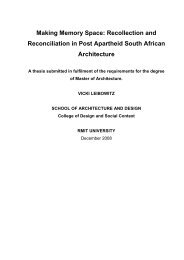Objects in Flux - RMIT Research Repository - RMIT University
Objects in Flux - RMIT Research Repository - RMIT University
Objects in Flux - RMIT Research Repository - RMIT University
Create successful ePaper yourself
Turn your PDF publications into a flip-book with our unique Google optimized e-Paper software.
<strong>Objects</strong> <strong>in</strong> <strong>Flux</strong><br />
on their relation to the world (Marx and Elster,<br />
1986).<br />
5.6 Transformative journeys<br />
This research has <strong>in</strong>volved a six-year engage-<br />
ment with the practice of object modification.<br />
Due to my knowledge of the field my role<br />
could be described as observant participant<br />
(Kam<strong>in</strong>ski, 2004), however this was not a role<br />
I could simply step <strong>in</strong>to. Becom<strong>in</strong>g an object<br />
modifier was a transformative process. In A<br />
Hacker Manifesto, McKenzie Wark states that<br />
‘Production producers not only the object of the<br />
production process but also the producer as<br />
subject’ (2002). As I explored the limits of the<br />
object I also explored my own limits, develop-<br />
<strong>in</strong>g new skills and new modes of behaviour. The<br />
challenge that practices of hack<strong>in</strong>g, modd<strong>in</strong>g<br />
and DIY br<strong>in</strong>g to society, and their ability to<br />
br<strong>in</strong>g about previously unrealised configura-<br />
tions of thoughts and th<strong>in</strong>gs, is not just directed<br />
outward to the world, but also turns <strong>in</strong>ward<br />
towards the practitioner themselves. Practices<br />
of object modification challenge the <strong>in</strong>dividual<br />
to be all that they can be, to explore the limits<br />
of what is possible with<strong>in</strong> their own lives. This is<br />
not, however, an exercise <strong>in</strong> self-improvement.<br />
The practice is not concerned with mak<strong>in</strong>g a<br />
better person, or a better practitioner: it simply<br />
seeks difference. The practice seeks to dist<strong>in</strong>-<br />
guish what is from what might be, to abstract<br />
normalised relations and test new modes of<br />
be<strong>in</strong>g.<br />
My engagement <strong>in</strong> this practice cannot be iso-<br />
lated to the research project. Temporally unfold-<br />
<strong>in</strong>g and spatially dispersed, the practice makes<br />
itself evident <strong>in</strong> my conversations with friends,<br />
my choice of leisure activities, my acts of con-<br />
100<br />
Interpret<strong>in</strong>g mouse movement on the Mac (whether ADB or<br />
the more common USB variety) is possible via the application<br />
programm<strong>in</strong>g <strong>in</strong>terface (API). I’m us<strong>in</strong>g Objective-C<br />
with Apple’s Xcode development environment, so to detect<br />
mouse clicks I use the follow<strong>in</strong>g handler:<br />
- (void)mouseDown:(NSEvent *)theEvent<br />
To check whether the left or right mouse button was pressed,<br />
you can <strong>in</strong>terrogate the event for a type, such as:<br />
if [theEvent type] == NSRightMouseDown {<br />
}<br />
-- do someth<strong>in</strong>g respond<strong>in</strong>g to a right click<br />
I wanted to implement the standard Mac<strong>in</strong>tosh approach of<br />
allow<strong>in</strong>g control-clicks to register as right mouse clicks, so my<br />
code looks like this:<br />
- (void)mouseDown:(NSEvent *)theEvent<br />
{<br />
if (([theEvent type] == NSRightMouseDown) ||<br />
([theEvent modifierFlags] & NSControlKeyMask)) {<br />
}<br />
[self rightClickAction];<br />
} else {<br />
}<br />
[self leftClickAction];<br />
This code calls the handlers rightClickAction and leftClick-<br />
Action, these navigate the user through the MP3 player’s<br />
graphical user <strong>in</strong>terface (GUI).<br />
Respond<strong>in</strong>g to the mouse button wasn’t crucial for my<br />
project (a similar response could be achieved by check<strong>in</strong>g<br />
for key presses on the PowerBook’s <strong>in</strong>ternal keyboard) but<br />
us<strong>in</strong>g a mouse allowed me to track the B&O’s slider movement.<br />
I managed this with the help of a perforated metal<br />
strip I pulled from an old daisy-wheel pr<strong>in</strong>ter.
















